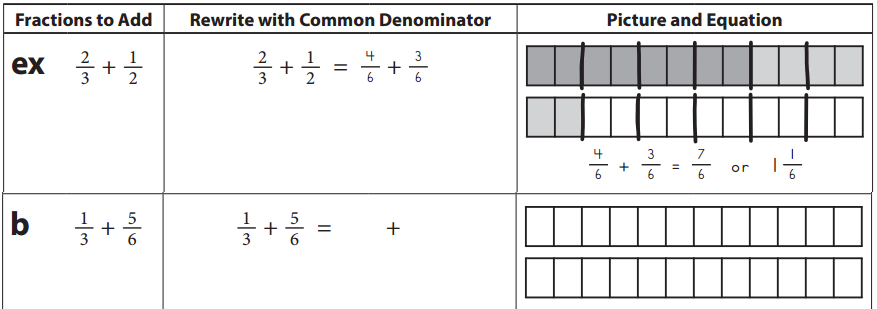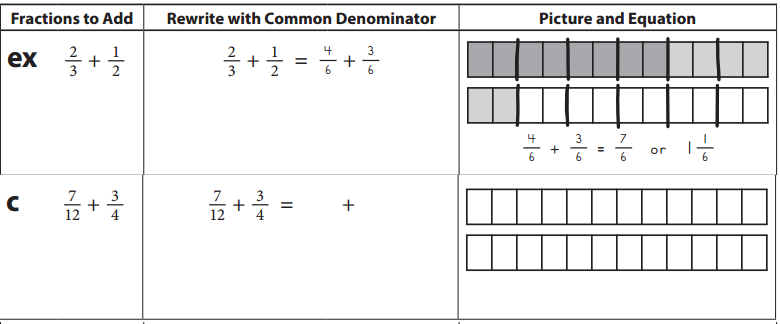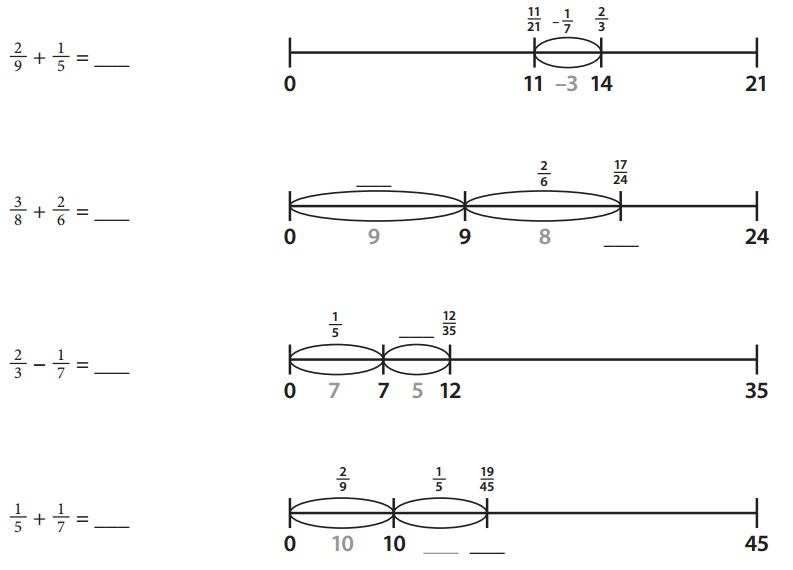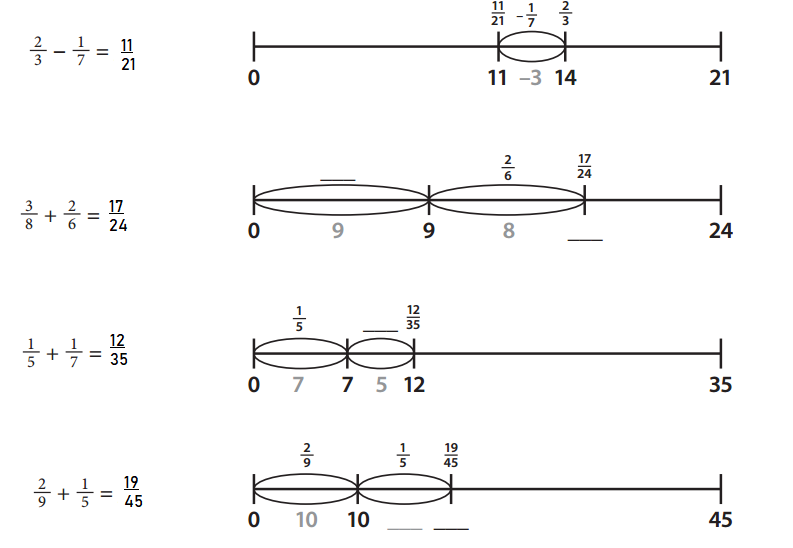Students looking for the Bridges in Mathematics Grade 5 Student Book Answer Key Unit 2 Module 2 can find a better approach to solve the problems.
Bridges in Mathematics Grade 5 Student Book Answer Key Unit 2 Module 2
Bridges in Mathematics Grade 5 Student Book Unit 2 Module 2 Session 1 Answer Key
Adding Fractions
Question 1.
Each bar below is divided into 12 equal pieces. Show each fraction on a fraction bar.

a. \(\frac{2}{3}\) 
Answer:

Explanation:
Each bar above is divided into 12 equal pieces.
Given, \(\frac{2}{3}\)
So, the whole is paired into 3 equal parts.
Hence 2/3 of the whole is shaded as shown above.
b. \(\frac{1}{4}\) 
Answer:

Explanation:
Each bar above is divided into 12 equal pieces.
Given, \(\frac{1}{4}\)
So, the whole is paired into 4 equal parts.
Hence 1/4 of the whole is shaded as shown above.
c. \(\frac{3}{4}\) 
Answer:

Explanation:
Each bar above is divided into 12 equal pieces.
Given, \(\frac{3}{4}\)
So, the whole is paired into 4 equal parts.
Hence 3/4 of the whole is shaded as shown above.
d. \(\frac{1}{2}\) 
Answer:

Explanation:
Each bar above is divided into 12 equal pieces.
Given, \(\frac{1}{2}\)
So, the whole is paired into 2 equal parts.
Hence half of the whole is shaded as shown above.
e. \(\frac{5}{6}\) 
Answer:

Explanation:
Each bar above is divided into 12 equal pieces.
Given, \(\frac{1}{4}\)
So, the whole is paired into 6 equal parts.
Hence 5/6 of the whole is shaded as shown above.
Question 2.
Rewrite each pair of fractions so that they have the same denominator. Then use the fraction bar pictures to show their sum. Write an equation to show both fractions and their sum.

Answer:

Explanation:
Given,
\(\frac{2}{3}\) + \(\frac{3}{4}\)
Rewrite each pair of fractions so that they have the same denominator.
So, take the L.C.M of 3 and 4 = 12
\(\frac{(2 × 4) + (3 × 3)}{12}\) = \(\frac{8 + 9}{12}\) = \(\frac{17}{12}\) = 1\(\frac{5}{12}\)

Answer:

Explanation:
Given,
\(\frac{1}{3}\) + \(\frac{5}{6}\)
Rewrite each pair of fractions so that they have the same denominator.
So, take the L.C.M of 3 and 6 = 6
\(\frac{(1 × 2) + (5 × 1)}{6}\) = \(\frac{2 + 5}{6}\) = \(\frac{7}{6}\) = 1\(\frac{1}{6}\)

Answer:

Explanation:
Given,
\(\frac{7}{12}\) + \(\frac{3}{4}\)
Rewrite each pair of fractions so that they have the same denominator.
So, take the L.C.M of 12 and 4 = 12
\(\frac{(7 × 1) + (3 × 3)}{12}\) = \(\frac{7 + 9}{12}\) = \(\frac{16}{12}\) = 1\(\frac{4}{12}\)
Bridges in Mathematics Grade 5 Student Book Unit 2 Module 2 Session 2 Answer Key
Work Place Instructions 2B Racing Fractions
Each pair of players needs:
- 1 Racing Fractions Game Board
- 1 Racing Fractions Record Sheet
- 1 deck of Racing Fractions Cards
- 8 red and 8 blue game marker
1.Each player places 1 game marker at 0 on each of the eight fraction number lines on the gameboard.
2. Each player places 1 game marker at 0 on each of the eight fraction number lines on the game board as shown above.
3. Each player chooses a fraction card. The player with the larger fraction goes first.
Player 1 takes a new fraction card and then moves one or more game markers the total distance shown on the card.
Player 2 checks Player 1’s work. If Player 2 disagrees, he has to convince Player 1 of his reasoning and Player 1 gets to try again.
Then, Player 2 takes a turn and Player 1 checks his work.
Players continue to take turns, record moves, and check each other’s work until all of one player’s game markers are on the 2s.
- If there is no possible move, the player loses the turn.
Game Variation
A Players play cooperatively and work together to help each other finish the track in a certain time period.
Fraction Story Problems
Question 1.
a. Measure the line below and make a mark along the line to show exactly where each of these fractions belongs. Be sure to label each mark with the name of the fraction.
\(\frac{1}{6}\), \(\frac{1}{4}\), \(\frac{1}{3}\), \(\frac{1}{2}\), \(\frac{2}{3}\), \(\frac{3}{4}\)

Answer:

Explanation:
Given,
\(\frac{1}{6}\), \(\frac{1}{4}\), \(\frac{1}{3}\), \(\frac{1}{2}\), \(\frac{2}{3}\), \(\frac{3}{4}\)
Measure the line below and make a mark along the line to show exactly where each of these fractions belongs as shown above.
b. Explain how you figured out where to place each fraction along the line.
Answer:
Fractions expand our number system beyond whole numbers and integers.
They help us denote any decimal number with higher precision.
Representation of Fractions on the number line is important to understand how fractions represent part of a whole.
Question 2.
Yesterday Carson recycled 1\(\frac{1}{3}\) pounds of paper packaging. He also recycled \(\frac{3}{4}\) of a pound of plastic packaging. Combined, how many pounds of packaging did Carson recycle yesterday? Show all your work.
Answer:
2\(\frac{1}{12}\)
Explanation:
Given,
Carson recycled 1\(\frac{1}{3}\) pounds of paper packaging.
He also recycled \(\frac{3}{4}\) of a pound of plastic packaging.
Combined pounds of packaging = 1\(\frac{1}{3}\) + \(\frac{3}{4}\)
= \(\frac{4}{3}\) + \(\frac{3}{4}\)
= \(\frac{4 × 4}{3 × 4}\) + \(\frac{3 × 3}{4 × 3}\)
= \(\frac{16}{12}\) + \(\frac{9}{12}\)
= \(\frac{16 + 9}{12}\)
= \(\frac{25}{12}\)
= 2\(\frac{1}{12}\)
Question 3.
Carmen ran 1\(\frac{3}{8}\) miles yesterday. Her sister Lola ran 2\(\frac{1}{4}\) miles. How much farther did Lola run than Carmen? Show all your work.
Answer:
=\(\frac{7}{8}\)
Explanation:
2\(\frac{1}{4}\) – 1\(\frac{3}{8}\) miles
= 2\(\frac{1}{4}\) – 1\(\frac{3}{8}\)
= \(\frac{9}{4}\) – \(\frac{11}{8}\)
= \(\frac{9 × 2}{4 × 2}\) – \(\frac{11}{8}\)
= \(\frac{18}{8}\) – \(\frac{11}{8}\)
=\(\frac{18 – 11}{8}\)
=\(\frac{7}{8}\)
Bridges in Mathematics Grade 5 Student Book Unit 2 Module 2 Session 3 Answer Key
Double Number Line
Question 1.
For each of the following:
- Draw a line from each equation to the matching double number line.
- Fill in the blanks on the last three double number lines.
- Record the answer to each equation.

Answer:

Explanation:
A double number line diagram uses a pair of parallel number lines to represent equivalent ratios.
The locations of the tick marks match on both number lines.
Given, \(\frac{2}{3}\) – \(\frac{1}{7}\)
= \(\frac{2 × 7}{3 × 7}\) – \(\frac{1 × 3}{7 × 3}\)
= \(\frac{14}{21}\) – \(\frac{3}{21}\)
= \(\frac{14 – 3}{21}\)
= \(\frac{11}{21}\)
\(\frac{3}{8}\) + \(\frac{2}{6}\)
= \(\frac{3 × 6}{8 × 6}\) + \(\frac{2 × 8}{6 × 8}\)
= \(\frac{18}{48}\) + \(\frac{16}{48}\)
= \(\frac{18 + 16}{48}\)
= \(\frac{34}{48}\)
= \(\frac{17}{24}\)
\(\frac{1}{5}\) + \(\frac{1}{7}\)
= \(\frac{1 × 7}{5 × 7}\) – \(\frac{1 × 5}{7 × 5}\)
= \(\frac{7}{35}\) – \(\frac{5}{35}\)
= \(\frac{12}{35}\)
\(\frac{2}{9}\) + \(\frac{1}{5}\)
= \(\frac{2 × 5}{9 × 5}\) + \(\frac{1 × 9}{5 × 9}\)
= \(\frac{10}{45}\) + \(\frac{9}{45}\)
= \(\frac{19}{45}\)
Question 2.
Use a double number line to solve these problems.
a. On Monday, Mr. Miles walked \(\frac{1}{9}\) of the trail to warm up and then he ran \(\frac{7}{8}\) of the trail. What fraction of the trail did Mr. Miles cover on Monday?
Answer:
\(\frac{71}{72}\) of the trail.
Explanation:
Given that,
On Monday, Mr. Miles walked \(\frac{1}{9}\) of the trail to warm up.
Then he ran \(\frac{7}{8}\) of the trail.
Total fraction of the trail did Mr. Miles cover on Monday,

\(\frac{1}{9}\) + \(\frac{7}{8}\)
= \(\frac{1× 8}{9 × 8}\) + \(\frac{7 × 9}{8 × 9}\)
= \(\frac{8}{72}\) + \(\frac{63}{72}\)
= \(\frac{8 + 63}{72}\)
= \(\frac{71}{72}\)
b. On Tuesday, Mr. Miles walked \(\frac{2}{9}\) of the trail to warm up and then he ran \(\frac{4}{6}\) of the trail. What fraction of the trail did Mr. Miles cover on Tuesday?
Answer:
\(\frac{8}{9}\) of the trail.
Explanation:
Given that,
On Tuesday, Mr. Miles walked \(\frac{2}{9}\) of the trail to warm up.
Then he ran \(\frac{4}{6}\) of the trail.
Total fraction of the trail did Mr. Miles cover on Tuesday,
\(\frac{2}{9}\) + \(\frac{4}{6}\)
= \(\frac{2× 2}{9 × 2}\) + \(\frac{4 × 3}{6 × 3}\)
= \(\frac{4}{18}\) + \(\frac{12}{18}\)
= \(\frac{4 + 12}{18}\)
= \(\frac{16}{18}\)
= \(\frac{8}{9}\)
C. On Wednesday, Mr. Miles walked and ran \(\frac{9}{10}\) of the trail. Then he walked \(\frac{1}{8}\) of the trail back and stopped to rest. What fraction of the course was Mr. Miles from the beginning of the trail when he stopped?
Answer:
\(\frac{31}{40}\) of the trail.
Explanation:
Given,
On Wednesday, Mr. Miles walked and ran \(\frac{9}{10}\) of the trail.
Then he walked \(\frac{1}{8}\) of the trail back and stopped to rest.
Total fraction of the course was Mr. Miles from the beginning of the trail when he stopped,
\(\frac{9}{10}\) – \(\frac{1}{8}\)
= \(\frac{9 × 8}{10 × 8}\) – \(\frac{1 × 10}{8 × 10}\)
= \(\frac{72}{80}\) – \(\frac{10}{80}\)
= \(\frac{72 – 10}{80}\)
= \(\frac{62}{80}\)
= \(\frac{31}{40}\)
d. On Thursday, Mr. Miles walked and ran \(\frac{19}{20}\) of the trail. Then he walked \(\frac{1}{3}\) of the trail back before he stopped to rest. What fraction of the trail was Mr. Miles from the beginning of the trail when he stopped?
Answer:
\(\frac{37}{60}\) of the trail.
Explanation:
Given that,
On Thursday, Mr. Miles walked and ran \(\frac{19}{20}\) of the trail.
Then he walked \(\frac{1}{3}\) of the trail back before he stopped to rest.
Total fraction of the trail was Mr. Miles from the beginning of the trail when he stopped,
\(\frac{19}{20}\) – \(\frac{1}{3}\)
= \(\frac{19 × 3}{20 × 3}\) – \(\frac{1 × 20}{3 × 20}\)
= \(\frac{57}{60}\) – \(\frac{20}{60}\)
= \(\frac{57 – 20}{60}\)
= \(\frac{37}{60}\)
Another Double Number Line
Question 1.
Solve the following.
a. \(\frac{1}{4}\) of 24
Answer:
6
Explanation:
Given,
\(\frac{1}{4}\) of 24
= \(\frac{1 × 24}{4}\)
= \(\frac{24}{4}\)
= 6
b. \(\frac{3}{4}\) of 24
Answer:
18
Explanation:
Given,
\(\frac{3}{4}\) of 24
= \(\frac{3 × 24}{4}\)
= 3 x 6
= 18
Question 2.
Solve the following.
a. \(\frac{1}{8}\) × 56
Answer:
7
Explanation:
Given,
\(\frac{1}{8}\) × 56
= \(\frac{56}{8}\)
= 7
b. \(\frac{3}{8}\) × 56
Answer:
21
Explanation:
Given,
\(\frac{3}{8}\) × 56
= \(\frac{3 × 56}{8}\)
= 3 x 7
= 21
Question 3.
Mark both the fraction and the distance traveled on the number line below.
a. \(\frac{1}{4}\) of 24 km
b. \(\frac{3}{4}\) × 24 km

Answer
6 km

Explanation:
A double number line diagram uses a pair of parallel number lines to represent equivalent ratios.
\(\frac{1}{4}\) of 24 km
= \(\frac{24}{4}\)
= 6 km
b. \(\frac{3}{4}\) × 24 km
Answer:
18 km

Explanation:
A double number line diagram uses a pair of parallel number lines to represent equivalent ratios.
Given,
\(\frac{3}{4}\) × 24
= \(\frac{3 × 24}{4}\)
= 3 x 6
= 18
Question 4.
Mark the fraction and the distance traveled on the number line below.
a. \(\frac{1}{8}\) × 56 km
b. \(\frac{3}{8}\) × of 56 km

Answer:

Explanation:
We know that,
A double number line diagram uses a pair of parallel number lines to represent equivalent ratios.
Given,
a. \(\frac{1}{8}\) × 56 km = 7 km.
b. \(\frac{3}{8}\) × of 56 km = 7 x 3 = 21 km.
Question 5.
Becky canoed \(\frac{7}{8}\) of the way down a 56 kilometer river. How many kilometers did she
canoe?
Answer:
49 km
Explanation:
Given,
Becky canoed \(\frac{7}{8}\) of the way down a 56 kilometer river.
Number of kilometers did she canoe = \(\frac{7}{8}\) x 56 = 7 x 7 = 49 km.
Bridges in Mathematics Grade 5 Student Book Unit 2 Module 2 Session 4 Answer Key
Add or Subtract Fractions
Question 1.
Solve the problems on this page. If your answer is an improper fraction, find its equivalent mixed number.
\(\frac{2}{3}\) + \(\frac{2}{3}\) = \(\frac{4}{3}\) = 1\(\frac{1}{3}\)
\(\frac{4}{3}\) is an improper fraction because 4 is greater than 3. \(\frac{3}{3}\) is equal to 1, so \(\frac{4}{3}\) is equal to 1\(\frac{1}{3}\).

Answer:

Explanation:
With reference to the above table given,
convert an improper fraction, to its equivalent mixed number as shown above.
If the denominators are same, then add or subtract the numerators and then simplify.
In case if the denominators are different, then make it equivalent or take L.C.M of the denominators and then add or subtract the numerators and then simplify.
Question 2.
Find two different ways to show that \(\frac{1}{2}\) + \(\frac{1}{4}\) is not equal to \(\frac{2}{6}\). You can use numbers, words, or labeled sketches.
Answer:
The following are the two different ways:
1. \(\frac{1}{2}\) + \(\frac{1}{4}\) = \(\frac{3}{4}\)
So, \(\frac{1}{2}\) + \(\frac{1}{4}\) is not equal to \(\frac{2}{6}\).
2. \(\frac{1}{2}\) + \(\frac{1}{4}\)
 +
+ 
So, \(\frac{1}{2}\) + \(\frac{1}{4}\) is not equal to \(\frac{2}{6}\).
Explanation:
Given,
\(\frac{1}{2}\) + \(\frac{1}{4}\) is not equal to \(\frac{2}{6}\).
When we simplify, \(\frac{1}{2}\) + \(\frac{1}{4}\) we get \(\frac{3}{4}\)
Bridges in Mathematics Grade 5 Student Book Unit 2 Module 2 Session 5 Answer Key
Work Place Instructions 2C Target Practice
Each pair of players needs:
- 1 spinner overlay
- 2 Target Practice Record Sheets
- pencils
1. Players decide who will be Player 1 and who will be Player 2.
2. Player 1 spins Spinner 1 twice and Spinner 2 twice and records all four numbers spun on the Record Sheet.
3. Player 1 chooses two of the numbers spun to create two unit fractions (fractions with 1 as the numerator) that have a sum as close to 1 as possible, and records the fractions created on the Record Sheet.
4. Player 1 finds the sum of the fractions.
5. Then, Player 1 finds her score by figuring out how far from one whole the sum is. Player 2 checks Player 1’s work.
6. Then it is Player 2’s turn.
7. After both players have finished Round 1, they compare scores and determine which is the smaller fraction. The player with the smaller score wins the round and circles his score. If the scores are the same, that round is a tie.
8. For rounds 2-5, players spin each spinner only one time to get two new numbers. They record the newly spun numbers and the two unused numbers from the previous round on their Record Sheet.
9. After five rounds, players compare how many rounds each won to determine the winner of the game.
Game Variations
A. Players spin for four new numbers in each round.
B. Player work together to find the smallest score on one record sheet rather than playing competitively.
C. Players do not determine a winner in each round, instead they add the five scores for each round to determine the winner of the game.
Better Buys
Question 1.
Michael was working on finding the better buy for granola bars: 8 bars for $10 or 20 bars for $23. Fill in each ratio table to find equivalents.
a.

Answer:

Explanation:
Given,
Michael was working on finding the better buy for granola bars: 8 bars for $10 or 20 bars for $23.
So, cost of each bar = $1.25
8 bars for $10 = 16 bars for $20 = 24 bars for $30 = 32 bars for $40 = 40 bars for $50
20 bars for $23 = 40 bars for $46
b.

Answer:

Explanation:
Given,
Michael was working on finding the better buy for granola bars: 8 bars for $10 or 20 bars for $23.
So, cost of each bar = $1.25
8 bars for $10 = 4 bars for $5 = 1 bar for $1.25
So, cost of each bar = $1.15
20 bars for $23 = 10 bars for $11.5 = 5 bars for $5.75 = 1 bar for $1.15
Therefore, the better buy is $1.15.
Question 2.
Now Michael wants to buy bags of mixed nuts. He can buy 12 bags for 15 dollars or 16 bags for $19.20. Fill in the ratio tables.
a.

Answer:

Explanation:
Given that,
Michael wants to buy bags of mixed nuts as 12 bags for 15 dollars or 16 bags for $19.20.
12 bags for $15 = 6 bags for $7.50 = 3 bags for $3.75 = 1 bag for $1.25
So, the cost of 1 bag = $1.25
16 bags for $19.20 = 8 bags for $9.6 = 4 bags for $4.8 = 1 bag for $1.2
So, cost of each bar = $1.2
Therefore, the better buy is $1.2
b. Explain how you can use the information in the tables to find the better buy of bags of mixed nuts.
Answer:
We can use the information in the tables to find the better buy of bags of mixed nuts by comparing the unit prices.
First we find the unit price of each item, then comparing the unit prices, we decide that the item with the smaller unit price is the “better buy”.
Bridges in Mathematics Grade 5 Student Book Unit 2 Module 2 Session 6 Answer Key
Fraction Estimate & Check
Before you solve each problem, look carefully at the fractions and write what you know about the sum or difference. Then find the exact sum or difference. Show all your work. If your answer is greater than 1, write it as a mixed number, not an improper fraction.
Question 1.
Problem
\(\frac{8}{3}\) + \(\frac{9}{12}\)
What you know before you start
The sum is more than 3.
Show your work
\(\frac{32}{12}\) + \(\frac{9}{12}\) = \(\frac{41}{12}\) and \(\frac{41}{12}\) = 3\(\frac{5}{12}\)
Exact sum or Difference
3\(\frac{5}{12}\)
Question 2.
Problem
\(\frac{1}{2}\) – \(\frac{5}{12}\)
What you know before you start
Show your work
Exact sum or Difference
Answer:
The difference is less than 1.
Explanation:
Given,
\(\frac{1}{2}\) – \(\frac{5}{12}\)
Take the L.C.M of 2 and 12 = 12
\(\frac{(1 × 6) – (5 × 1)}{12}\) = \(\frac{6 – 5}{12}\) = \(\frac{1}{12}\)
So, the difference is less than 1.
Question 3.
Problem
\(\frac{3}{10}\) + \(\frac{4}{5}\)
What you know before you start
Show your work
Exact sum or Difference
Answer:
The sum is more than 1.
Explanation:
Given,
\(\frac{3}{10}\) + \(\frac{4}{5}\)
Take the L.C.M of 10 and 5 = 5
\(\frac{(3 × 1) + (4 × 2)}{10}\) = \(\frac{3 + 8}{10}\) = \(\frac{11}{10}\)
Exact sum is 1\(\frac{1}{10}\)
So, the sum is more than 1.
Question 4.
Problem
\(\frac{3}{4}\) – \(\frac{1}{5}\)
What you know before you start
Show your work
Exact sum or Difference
Answer:
The difference is less than 1.
Explanation:
Given,
\(\frac{3}{4}\) – \(\frac{1}{5}\)
Take the L.C.M of 4 and 5 = 20
\(\frac{(3 × 5) – (1 × 4)}{20}\) = \(\frac{15 – 4}{20}\) = \(\frac{11}{20}\)
So, the difference is less than 1.
Question 5.
Problem
\(\frac{12}{6}\) – \(\frac{8}{12}\)
What you know before you start
Show your work
Exact sum or Difference
Answer:
The some is more than 2.
Explanation:
Given,
\(\frac{12}{6}\) + \(\frac{8}{12}\)
Take the L.C.M of 6 and 12 = 12
\(\frac{(12 × 2) + (8 × 1)}{12}\) = \(\frac{24 + 8}{12}\) = \(\frac{32}{12}\)
Exact sum is 2\(\frac{8}{12}\)
So, the sum is more than 2.
Question 6.
Problem
\(\frac{12}{8}\) + \(\frac{3}{4}\)
What you know before you start
Show your work
Exact sum or Difference
Answer:
The some is more than 2.
Explanation:
Given,
\(\frac{12}{8}\) + \(\frac{3}{4}\)
Take the L.C.M of 8 and 4 = 8
\(\frac{(12 × 1) + (3 × 2)}{8}\) = \(\frac{12 + 6}{8}\) = \(\frac{18}{8}\)
Exact sum is 2\(\frac{2}{8}\)
So, the sum is more than 2.